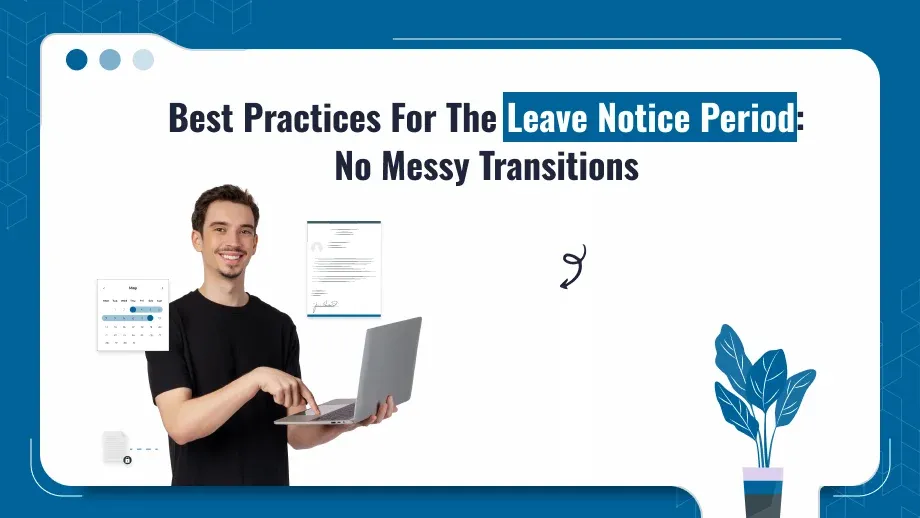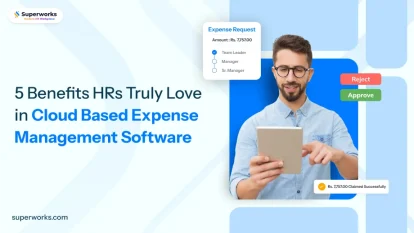
When an employee resigns, the timer starts ticking until they leave the company. The leave notice period is a critical phase where both the employee and the company can prepare for the transition. Get it right and you’ll have a smooth handover of responsibilities, the smallest business disruption and maintain connections.
In this post, we’ll go into the leave notice period what’s it, how to manage it, legal conditions, and smart practices to minimize the impact on the business. We’ll also cover what to do during probation and what happens when workers take leave during the notice period.
1. What Is The Leave Notice Period?
The leave notice period is the time between when an employee resigns and their last day. During this time the employee is still expected to work, while the company finds a reserve or-allocates tasks. It’s a contractual agreement that gives both the employee and employer a buffer to prepare for the exit.
Why is the leave Notice Period Important?
It serves:
- Smooth Transition: The company has time to hand over responsibilities.
- Knowledge Transfer: The employee can document processes or train their replacement.
- No Business Disruption: The organization can ensure no key projects or tasks are left unattended.
The notice period varies by organization and role. For entry or mid-level positions a month is common. For more senior roles the employee notice period can be 3-6 months. This longer period reflects the greater responsibilities and impact of the employee leaving the company.
2. How to Set the Right Notice Period
Setting the right notice period is crucial. It gives the company time to manage the transition and find a replacement while respecting the employee’s need to leave promptly. Here are some factors to consider:
Factors to Consider
- Seniority and Responsibility Level Employees in higher-level positions (team leaders, executives) have longer leave during the notice period. Their departure can impact the business. If a department head leaves without a proper handover it can disrupt workflows and delay projects. So a 3-6 month notice period is common for these roles.
- Specialized Roles Roles that require special skills (technical, creative) have longer notice periods than general roles. These employees have unique skills and finding a replacement takes time. A technical engineer for example may have a longer employee notice period than a general admin staff.
- Company Size and Industry Small businesses and startups have shorter notice periods due to their fast-paced nature. Larger organizations need more time to adjust to staff changes so have longer notice periods. Industries with strict regulations (finance, healthcare) may have longer notice periods to ensure compliance and no disruption.
- Notice Period During Probation During probation the leave Application during notice period is shorter. Employees under notice during probation are new hires and the company is still assessing their fit for the role. A shorter period (1 week to 1 month) benefits both parties, a quick exit if the fit isn’t right.
3. Managing the Leave Notice Period: What to Do
Once an employee has resigned there are specific steps to follow during the leave notice period:
Step 1: Confirm the Resignation
The first thing to do after receiving a resignation is to formally confirm it. Confirm the length of the notice period according to the employee’s contract and agree on the last day of work. This sets the expectation for both the employee and employer.
Step 2: Handover
Handover planning is key. During the notice period document:
- Key tasks and ongoing projects
- Who will take over
- Documentation or training for the replacement
Handover is especially important for specialist roles. Transfer of critical knowledge to the right person will reduce the impact on the business.
Step 3: Inform Team and Stakeholders
Inform the relevant team and stakeholders of the resignation. So everyone can prepare for the transition and any changes can be made in time.
Step 4: Exit Interview
During the notice period, an exit interview can provide valuable feedback. This information will help the organization identify areas to improve in their leave policy for employees, management practices, or overall culture.
Reduce disruption during the leave notice period by 80%.
Now is the time to implement a comprehensive leave management system.
4. Legal Requirements During the Notice Period
Both employees and employers must comply with legal requirements during the notice period. These can vary by country and industry but generally include:
Minimum Notice Periods
In many countries, there are statutory fewest notice periods that must be met. These can be influenced by the length of service. For the sample, employees who have been with the company for less than 2 years may have a 1-week notice period, and those with more than 2 years may have up to 12 weeks notice.
Contractual Notice Periods
Beyond the statutory minimums, many companies have longer contractual notice periods. These are outlined in the notice period and sick leave policy in the employment contract. Employers must honor these or face legal action.
What happens if the Notice Period is broken?
If an employee leaves before the end of the notice period without employer allowance they may be in breach of contract. Employers can take legal action or withhold benefits if the contract terms aren’t met. If an employer asks an employee to leave before the agreed date without sufficient notice the employee may be entitled to compensation.
5. Reducing the Disruption During the Leave Notice Period
Even when managed well the notice period can still cause some disruption especially if the leaving employee is a key person. But there are ways to reduce this:
Cross Training
Cross-training workers to do different tasks means no one is critical. This way when a critical employee resigns the transition is smoother because others can take over their responsibilities more easily.
Delegation
During the notice period start delegating the leaving employee’s tasks to their confreres or the new hire. So there’s no knowledge vacuum when they finally leave.
Technology
Using a leave management system or HRMS software in India can help track tasks and ensure nothing is missed during the transition. These tools help to organize and structure the workflow. This is especially helpful for larger teams where the handover process can get complex.
Leave during the Notice Period
Employees may request leave encashment policy during their notice period for various reasons such as using up remaining holidays or attending to personal matters. This can complicate the handover but employers can choose to deduct the leave from the notice period on probation or ask the employee to do certain tasks remotely.
6. Notice Period during Probation
The notice period during probation is shorter than for full-time employees who have completed their probation. Since both employer and employee are still assessing the fit during probation the notice period resignation is usually 1-4 weeks. If either party decides the role isn’t working out a shorter notice period means minimal disruption.
What happens if an employee leaves during Probation?
Employees leaving during probation are subject to less stringent requirements than long-term employees. But still, you should follow the agreed notice period in the employment contract. Shorter notice periods mean both the employee and employer can move on without unnecessary delays.
7. Define a Clear Notice Period Policy
A good notice period policy will avoid confusion and legal issues when employees resign. It should cover:
- The standard notice period for the role.
- The process of resignation and how the leave notice period will be managed.
- Leave during the notice period.
- Penalties for breaching the contract or leaving before the notice period ends.
By having a notice period policy you can have smooth transitions and avoid legal headaches.
Summary
Managing the leave notice period is key to a smooth transition and protecting the business. Whether the employee is on probation or a long-term staff member a structured approach to the leave notice period reduces disruption and knowledge transfer.
Employers need to have clear policies, comply with the law, and maintain open communication to make it work. Using tools like a leave management system or HRMS platform ensures everything is tracked and documented so the transition is seamless and efficient when an employee leaves. Whether it’s a new hire on probation or a long-serving employee in a leadership role clear guidelines and planning are key.
By managing the leave notice period resignation you can reduce disruption, protect the business, and have employees leave the organization on good terms.





